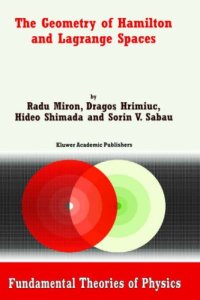
Ebook: The Geometry of Hamilton and Lagrange Spaces
- Genre: Mathematics
- Tags: Differential Geometry, Applications of Mathematics
- Series: Fundamental Theories of Physics 118
- Year: 2002
- Publisher: Springer Netherlands
- City: Dordrecht; Boston
- Edition: 1
- Language: English
- pdf
The title of this book is no surprise for people working in the field of Analytical Mechanics. However, the geometric concepts of Lagrange space and Hamilton space are completely new. The geometry of Lagrange spaces, introduced and studied in [76],[96], was ext- sively examined in the last two decades by geometers and physicists from Canada, Germany, Hungary, Italy, Japan, Romania, Russia and U.S.A. Many international conferences were devoted to debate this subject, proceedings and monographs were published [10], [18], [112], [113],... A large area of applicability of this geometry is suggested by the connections to Biology, Mechanics, and Physics and also by its general setting as a generalization of Finsler and Riemannian geometries. The concept of Hamilton space, introduced in [105], [101] was intensively studied in [63], [66], [97],... and it has been successful, as a geometric theory of the Ham- tonian function the fundamental entity in Mechanics and Physics. The classical Legendre’s duality makes possible a natural connection between Lagrange and - miltonspaces. It reveals new concepts and geometrical objects of Hamilton spaces that are dual to those which are similar in Lagrange spaces. Following this duality Cartan spaces introduced and studied in [98], [99],..., are, roughly speaking, the Legendre duals of certain Finsler spaces [98], [66], [67]. The above arguments make this monograph a continuation of [106], [113], emphasizing the Hamilton geometry.
This monograph presents for the first time the foundations of Hamilton Geometry. The concept of Hamilton Space, introduced by the first author and investigated by the authors, opens a new domain in differential geometry with large applications in mechanics, physics, optimal control, etc. The book consists of thirteen chapters. The first three chapters present the topics of the tangent bundle geometry, Finsler and Lagrange spaces. Chapters 4-7 are devoted to the construction of geometry of Hamilton spaces and the duality between these spaces and Lagrange spaces. The dual of a Finsler space is a Cartan space. Even this notion is completely new, its geometry has the same symmetry and beauty as that of Finsler spaces. Chapter 8 deals with symplectic transformations of cotangent bundle. The last five chapters present, for the first time, the geometrical theory and applications of Higher-Order Hamilton spaces. In particular, the case of order two is presented in detail. Audience: mathematicians, geometers, physicists, and mechanicians. This volume can also be recommended as a supplementary graduate text.